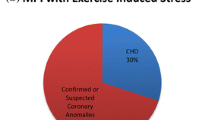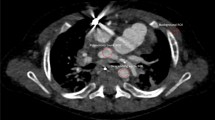Abstract
Introduction
The prevalence of defects and effective radiation dose from various myocardial perfusion imaging (MPI) strategies in congenital heart disease (CHD) is unknown.
Methods
We studied 75 subjects with complex CHD (ages 5 to 80 years) referred for MPI between 2002 and 2015. A rest and exercise or pharmacologic stress MPI was performed using 99mTechnetium sestamibi, 82rubidium or 13N-ammonia, and Sodium iodide SPECT (single-photon emission computed tomography), SPECT/CT or Cadmium zinc telluride (CZT) SPECT or PET (positron emission tomography)/CT scanners. Deidentified images were interpreted semi-quantitatively in three batches: stress only MPI, stress/rest MPI, and stress/rest MPI with taking into account a history of ventricular septal defect repair. Effective radiation dose was estimated for stress/rest MPI and predicted for 1-day stress-first (normal stress scans), and for 2-day stress/rest MPI (abnormal stress scans).
Results
The median age was 18.6 years. The most common type of CHD was transposition of the great arteries (63%). Rest/stress MPI was abnormal in 43% of subjects and 25% of the abnormal scans demonstrated reversible defects. Of the subjects with abnormal MPI, 33% had significant underlying anatomic coronary artery obstruction. Estimated mean effective radiation dose ranged from 2.1 ± 0.6 mSv for 13N-ammonia PET/CT to 12.5 ± 0.9 mSv for SPECT/CT. Predicted effective radiation dose was significantly lower for stress-first MPI and for 2-day stress/rest protocols.
Conclusions
Due to the relatively high prevalence of abnormal stress MPI, tailored protocols with a stress-first MPI as well as the use of 2-day protocols and advanced imaging technologies including CZT SPECT, novel image reconstruction software, and PET MPI could substantially reduce radiation dose in complex CHD.







Similar content being viewed by others
Abbreviations
- CHD:
-
Congenital heart disease
- CMR:
-
Cardiac magnetic resonance
- CZT:
-
Cadmium zinc telluride
- MPI:
-
Myocardial perfusion imaging
- NaI:
-
Sodium iodide
- PET:
-
Positron emission tomography
- SPECT:
-
Single-photon emission computed tomography
- VSD:
-
Ventricular septal defect
References
Warnes CA, Liberthson R, Danielson GK, et al. Task force 1: The changing profile of congenital heart disease in adult life. J Am Coll Cardiol 2001;37:1170-5.
Marelli AJ, Mackie AS, Ionescu-Ittu R, Rahme E, Pilote L. Congenital heart disease in the general population: Changing prevalence and age distribution. Circulation 2007;115(2):163-72.
Deen JF, Krieger EV, Slee AE, et al. Metabolic syndrome in adults with congenital heart disease. J Am Heart Assoc 2016;5:e001132.
Giannakoulas G, Dimopoulos K, Engel R, et al. Burden of coronary artery disease in adults with congenital heart disease and its relation to congenital and traditional heart risk factors. Am J Cardiol 2009;103:1445-50.
Yalonetsky S, Horlick EM, Osten MD, Benson LN, Oechslin EN, Silversides CK. Clinical characteristics of coronary artery disease in adults with congenital heart defects. Int J Cardiol 2013;164:217-20.
Partington SL, Valente AM, Landzberg M, Grant F, Di Carli MF, Dorbala S. Clinical applications of radionuclide imaging in the evaluation and management of patients with congenital heart disease. J Nucl Cardiol 2016;23:45-63.
Morray BH, McElhinney DB, Cheatham JP, et al. Risk of coronary artery compression among patients referred for transcatheter pulmonary valve implantation: a multicenter experience. Circ Cardiovasc Interv 2013;6:535-42.
Bonnet D, Bonhoeffer P, Piechaud JF, et al. Long-term fate of the coronary arteries after the arterial switch operation in newborns with transposition of the great arteries. Heart 1996;76:274-9.
Tanel RE, Wernovsky G, Landzberg MJ, Perry SB, Burke RP. Coronary artery abnormalities detected at cardiac catheterization following the arterial switch operation for transposition of the great arteries. Am J Cardiol 1995;76:153-7.
Hill KD, Frush DP, Han BK, et al. Radiation safety in children with congenital and acquired heart disease: a scientific position statement on multimodality dose optimization from the image gently alliance. JACC Cardiovasc Imaging 2017;10:797-818.
Di Carli MF, Dorbala S, Meserve J, El Fakhri G, Sitek A, Moore SC. Clinical myocardial perfusion PET/CT. J Nucl Med 2007;48:783-93.
DePuey EG, Ata P, Wray R, Friedman M. Very low-activity stress/high-activity rest, single-day myocardial perfusion SPECT with a conventional sodium iodide camera and wide beam reconstruction processing. J Nucl Cardiol 2012;19:931-44.
DePuey EG. Advances in SPECT camera software and hardware: currently available and new on the horizon. J Nucl Cardiol 2012;19(3):551-81 quiz 585.
Chang SM, Nabi F, Xu J, Raza U, Mahmarian JJ. Normal stress-only versus standard stress/rest myocardial perfusion imaging: similar patient mortality with reduced radiation exposure. J Am Coll Cardiol 2010;55:221-30.
Dorbala S, Blankstein R, Skali H, et al. Approaches to reducing radiation dose from radionuclide myocardial perfusion imaging. J Nucl Med 2015;56:592-9.
Kuebler JD, Chen MH, Alexander ME, Rhodes J. Exercise performance in patients with D-loop transposition of the great arteries after arterial switch operation: Long-term outcomes and longitudinal assessment. Pediatr Cardiol 2016;37:283-9.
Cerqueira MD, Weissman NJ, Dilsizian V, et al. Standardized myocardial segmentation and nomenclature for tomographic imaging of the heart. A statement for healthcare professionals from the Cardiac Imaging Committee of the Council on Clinical Cardiology of the American Heart Association. J Nucl Cardiol 2002;9:240-5.
Hachamovitch R, Berman DS, Kiat H, et al. Exercise myocardial perfusion SPECT in patients without known coronary artery disease: incremental prognostic value and use in risk stratification. Circulation 1996;93:905-14.
Hachamovitch R, Hayes SW, Friedman JD, Cohen I, Berman DS. A prognostic score for prediction of cardiac mortality risk after adenosine stress myocardial perfusion scintigraphy. J Am Coll Cardiol 2005;45:722-9.
Cohen HA, Baird MG, Rouleau JR, et al. Thallium 201 myocardial imaging in patients with pulmonary hypertension. Circulation 1976;54:790-5.
Mannting F, Zabrodina YV, Dass C. Signifiance of increased right ventricular uptake on 99mTc-sestamibi SPECT in patients with coronary artery disease. J Nucl Med 1999;40:889-94.
Dorbala S, Di Carli MF, Delbeke D, et al. SNMMI/ASNC/SCCT guideline for cardiac SPECT/CT and PET/CT 1.0. J Nucl Med 2013;54:1485-507.
Stout KK, Daniels KG, Aboulhosn JA, Bozkurt B, Broberg CS, Colman JM, Crumb SR, Dearani JA, Fuller S, Gurvitz M, Khairy P, Landzberg MJ, Saidi A, Valente AM, Van Hare GF. AHA/ACC Guideline for the Management of Adults with congenital heart disease. J Am Coll Cardiol 2018;18:SO735-1097.
Einstein AJ, Pascual TN, Mercuri M, et al. Current worldwide nuclear cardiology practices and radiation exposure: results from the 65 country IAEA Nuclear Cardiology Protocols Cross-Sectional Study (INCAPS). Eur Heart J 2015;36:1689-96.
Iskandrian AE. Stress-only myocardial perfusion imaging a new paradigm. J Am Coll Cardiol 2010;55:231-3.
Einstein AJ, Johnson LL, DeLuca AJ, et al. Radiation dose and prognosis of ultra-low-dose stress-first myocardial perfusion SPECT in patients with chest pain using a high-efficiency camera. J Nucl Med 2015;56:545-51.
Einstein AJ, Blankstein R, Andrews H, et al. Comparison of image quality, myocardial perfusion, and left ventricular function between standard imaging and single-injection ultra-low-dose imaging using a high-efficiency SPECT camera: the MILLISIEVERT study. J Nucl Med 2014;55:1430-7.
Patton JA, Turkington TG. SPECT/CT physical principles and attenuation correction. J Nucl Med Technol 2008;36:1-10.
Abbott BG, Case JA, Dorbala S, et al. Contemporary Cardiac SPECT imaging-innovations and best practices: An information statement from the american society of nuclear cardiology. J Nucl Cardiol 2018;25:1847-60.
Dorbala S, Ananthasubramaniam K, Armstrong IS, et al. Single photon emission computed tomography (SPECT) Myocardial Perfusion Imaging Guidelines: Instrumentation, acquisition, processing, and interpretation. J Nucl Cardiol 2018;25:1784-846.
Henzlova MJ, Duvall WL, Einstein AJ, Travin MI, Verberne HJ. ASNC imaging guidelines for SPECT nuclear cardiology procedures: Stress, protocols, and tracers. J Nucl Cardiol 2016;23:606-39.
Disclosure
Sharmila Dorbala has received consulting fees from GE and research support from Pfizer. Ron Blankstein has received research support from Astellas Inc. and Amgen Inc. Marcelo F. DiCarli has received research support from Spectrum Dynamics and Gilead. Hicham Skali has received stock options in Optimize Rx for consulting role. Viviany R. Taqueti, Anne Marie Valente, Sara L. Partington, John Bruyere, Dillenia Rosica, Keri M. Shafer, Michael J. Landzberg, Neha Kwatra, and Frederick D. Grant have nothing to disclose.
Author information
Authors and Affiliations
Corresponding author
Additional information
Publisher's Note
Springer Nature remains neutral with regard to jurisdictional claims in published maps and institutional affiliations.
The authors of this article have provided a PowerPoint file, available for download at SpringerLink, which summarises the contents of the paper and is free for re-use at meetings and presentations. Search for the article DOI on SpringerLink.com.
All editorial decisions for this article, including selection of reviewers and the final decision, were made by guest editor Daniel S. Berman, MD.
Electronic supplementary material
Below is the link to the electronic supplementary material.
Rights and permissions
About this article
Cite this article
Partington, S.L., Valente, A.M., Bruyere, J. et al. Reducing radiation dose from myocardial perfusion imaging in subjects with complex congenital heart disease. J. Nucl. Cardiol. 28, 1395–1408 (2021). https://doi.org/10.1007/s12350-019-01811-y
Received:
Accepted:
Published:
Issue Date:
DOI: https://doi.org/10.1007/s12350-019-01811-y




